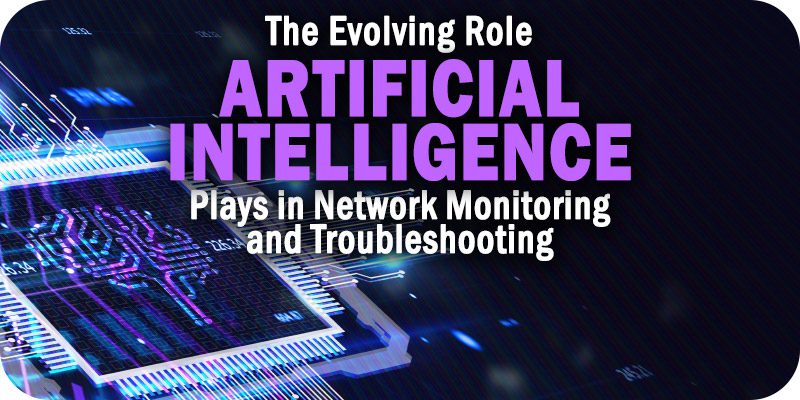The Evolving Role AI Plays in Network Monitoring and Troubleshooting


As part of Solutions Review’s Premium Content Series—a collection of contributed columns written by industry experts in maturing software categories—Patrick MeLampy of Juniper Networks provides insights on the evolving role that AI is playing in network monitoring and troubleshooting processes for IT teams.
 Troubleshooting customer problems can be one of a provider’s biggest wastes of time. The leading judgment point is how fast service can be restored, regardless of what caused the problem, especially since every second down increases customer dissatisfaction. However, the ever-expanding size and reach of today’s networks, combined with the labor and skills shortage the industry faces, means this becomes an increasingly complex problem to manage without spending hours on menial tasks and troubleshooting.
Troubleshooting customer problems can be one of a provider’s biggest wastes of time. The leading judgment point is how fast service can be restored, regardless of what caused the problem, especially since every second down increases customer dissatisfaction. However, the ever-expanding size and reach of today’s networks, combined with the labor and skills shortage the industry faces, means this becomes an increasingly complex problem to manage without spending hours on menial tasks and troubleshooting.
This is where artificial intelligence (AI) can help. By applying AI to network monitoring and management, problems can be pinpointed faster, with assistance in repairing them.
The Ever-Increasing Network Environment
The network environment itself has increased tenfold these past few years. With the rush to deliver mobile applications and services during the pandemic, many new devices and equipment were put into service—all connecting to the network—with very little thought given to what the situation might be a few years later. Companies are now grappling with those decisions.
It is no longer possible to depend on the traditional IT team structure for operating and managing a network. The idea of managing or troubleshooting by reviewing log files or answering every alert that comes in should be ancient history at this point. The process was already time-consuming, and by increasing the team’s environment, the task became nearly impossible.
If a team spends hours reviewing files and alerts to find problems and determine what to fix, they cannot work on more critical business-level issues. In short, the team isn’t used to the best of their abilities, and the job becomes less appealing with each mundane task piled on their plates.
AI to the Rescue
AI can constantly monitor network environments and provide alerts on any critical issues that need to be addressed, eliminate false alarms, and help the team de-prioritize issues that can be dealt with later. Using AI frees team members to work on higher-value tasks and responsibilities instead of mundane, repeatable tasks.
For example, imagine a wireless outage within a particular area of an office. No one knows why the coverage drops in a specific area. To find the answer using traditional methods would require a time-consuming, trial-and-error approach, where an IT team member has to review area devices and connections, working their way down a checklist until they find the issue. But what if the problem was a chewed-through power cord on a router? Or a bad cable? How far down the checklist would those potential causes be, and how much valuable time would be wasted trying to get to that answer?
With AI-powered intelligence in place, the checklist of possibilities would be automatically reviewed, allowing a cause to be discovered almost instantaneously. AI lets the team immediately troubleshoot and understand an issue, whether it’s an incorrect setting, a ruined cord, a misconfiguration, or network interference. Even if it doesn’t see the cause immediately, AI can approach a problem the way an IT team member might by pulling together traces of information from multiple sources to determine where the fault most likely lies. AI can accomplish this much faster than any human technician could.
AI technology can also help determine the “time to innocence” and identify whether the issue is a network or application problem. AI technology can access information on all the cloud applications in use at an organization (Microsoft 365, etc.) and compare and contrast results from different networks in real-time. This helps the IT team delineate between global or local problems and whether the application issue is “in the network” or “outside the network.”
In the future, AI will also take a more proactive role in identifying issues to repair before they become full-blown user complaints, enabling the IT and network management teams to stay a step ahead of employees. In addition, AI technology can provide recommended fixes for the problems it uncovers, helping to speed time to repair and assist those team members tasked to fix something without having the requisite experience of dealing with a similar issue.
Protecting the User Experience
The user experience has become increasingly important and is even more critical now as organizations are looking to attract and retain talent at all levels. An organization’s technology must work for employees to be efficient and effective. Suppose employees cannot access critical data, applications, and information for any length of time. In that case, the business suffers, and the blame (rightly or wrongly) will be placed on the shoulders of the IT and network management teams.
Applying AI to the network monitoring and troubleshooting process enables IT and network management teams to maintain the user experience at a high level, as problems are quickly discovered and repaired, and downtime and outages will decrease. Employees are happier and more effective, while IT team members can put their valuable time and efforts toward more critical issues instead of troubleshooting their way down a list.





















